Unimax Communications UMX40INT Mobile Phone User Manual
Unimax Communications Mobile Phone
User Manual

==
MXG-408
Quick Start Guide
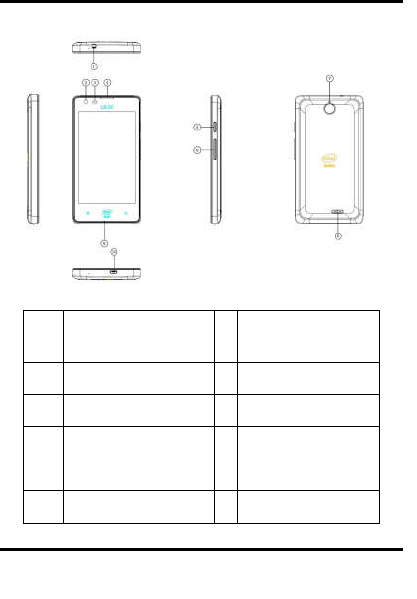
Product Overview
Earphone 3.5mm Slot
Front-Camera
P-sensor
Receiver
Power Key
Volume Key +/-
Rear-Camera
⑧
Speaker
⑨
Mic
⑩
Micro USB 2.0 HS
1
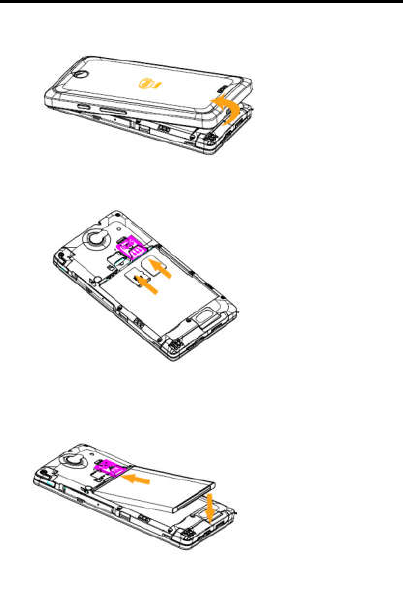
Remove the back cover
Assemble SIM Card & MicroSD card (if applicable)
Assemble the battery
2
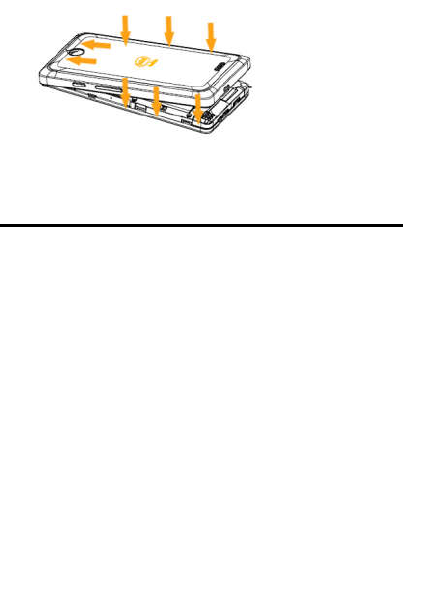
Assemble the back cover
Getting Started
Turning the phone On/Off
To turn On the phone
1. Press and hold the PWR key for a few seconds.
2. Unlock the screen with your finger.
To turn Off the phone
1. Press and hold the PWR key, select Power Off.
2. Tap OK. The phone will be off in a few seconds.
Unlocking Screen
The screen is locked by default when you turn on the phone. To unlock the
screen.
1. Press the PWR key.
3
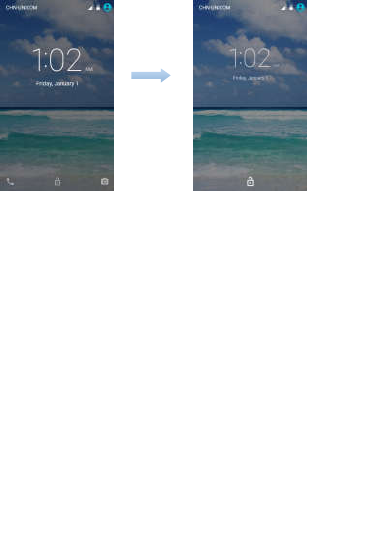
2. Up sliding screen to unlock the screen. Draw a pattern if the screen is
protected by pattern lock. Enter a PIN or a password if the screen is
locked by a PIN or a password.
Locking screen
To lock the screen, press the PWR key. It is recommended to lock the
screen to protect information in the phone and reduce battery usage.
You can also configure your phone to automatically lock after a certain
period of me. Tap → Sengs → Display → Sleep to set the sleep time
from 15 seconds, 30 seconds, 1 minute, 2 minutes, 5 minutes, 10 minutes,
or 30 minutes.
Using touch screen
All of the functions of the phone, except for power and volume, are
performed on the touch screen. Therefore, it is essential to know how to
use the touch screen.
The following finger actions might help you easily understand how to use
the touch screen.
Tap: Touch an item (e.g. application or widget) once that appears on
the screen with your finger to run it or access a menu or an option
Double tap: Tap an item twice with your finger
4

Drag: Tap and hold your finger on an item and move it without losing
contact with the screen
Flick: Place a finger on an empty space of the screen and move the
screen up or down, or left or right
Pinch: Place two fingers on the screen and move them apart to zoom
in a picture, a document or a web page, or move them together to
zoom out
Select and tap: Tap an item in the list of options available
Press and hold: Press a key or any item for a few seconds until a list
of options appears
Cautions:
Do not use sharp tools that can scratch the touch screen.
Do not allow the touch screen to come in contact with chemicals. The
screen may malfunction in chemicals.
Do not sit on the phone: the touch screen can be damaged.
Status bar
The status bar at the top of the screen notifications from various apps,
time, and the states of various devices such as battery status, WLAN status,
Signal status and so on.
1. Notification panel displays notification icons to inform you of new
Email, messages, and so on. Slide the panel down to view the
notifications and then tap a notification icon to view details of the
notification.
5
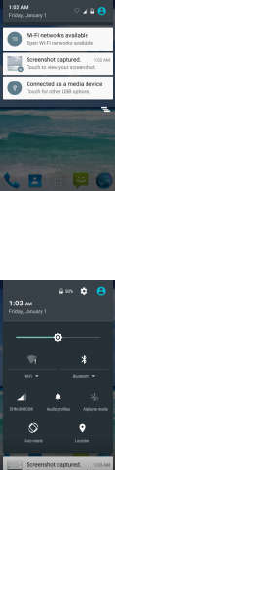
2. Status panel displays status icons to show the current state of your
phone, such as battery charging progress, alarms, Bluetooth, and so on.
Slide the panel down to access more settings and configuration options.
Screen orientation
For optimal viewing experience, the screen orientation changes
automatically depending on how you hold the phone.
NOTE: To enable or disable auto-rotate, slide down the status panel and
6
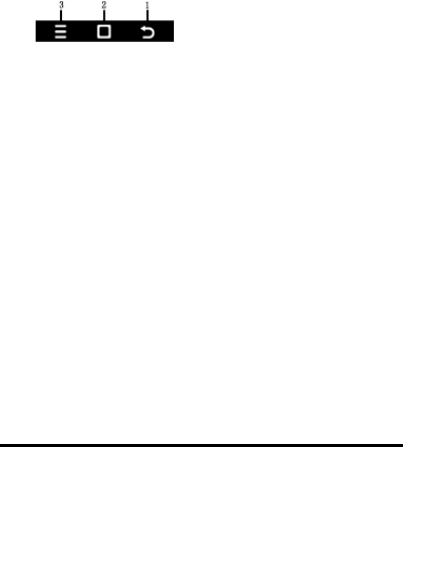
tap the Auto-rotate icon.
Keys and functions
1. Back key
Tap to return to the previous screen and exit the running application.
Tap to close the on-screen keyboard in text input mode.
2. Home key
Tap to return to the main screen.
Tap and hold to open the Google search.
3. Menu key
Tap to open the applications list used recently.
Apps and widgets
Apps: Software that allows you to perform a specific task. Your phone is
preloaded with a variety of applications, and additional applications can
be downloaded from the Play Store.
Widgets: A small application which resides on the home screen and
provides quick and easy access to information.
Connecting to the Internet using WLAN
NOTE: The range and quality of the WLAN signal is affected by the
distance between the phone and the wireless router, the number of
connected devices, infrastructure, and objects through which the signal
is transmitted.
7
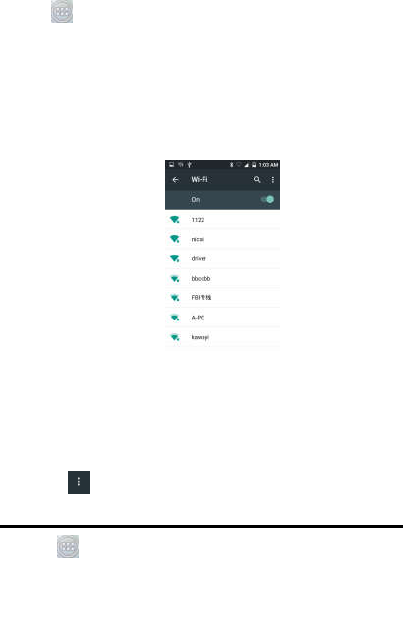
1. Tap → Sengs→ WIRELESS & NETWORKS→ WLAN.
2. Enable WLAN by moving the slider to On position. The phone scans
for WLAN networks in range.
3. Tap the network you want to connect to.
4. Type a password (if connecting to a secure network) and tap Connect
to connect to the selected WLAN network.
NOTE: To connect to a secured WLAN network, you must provide the secu
rity key. If you do not have the security key, contact the person who
manages your WLAN network or the router manufacturer.
NOTE: To start a new search for available WLAN networks, on the WLAN
screen, tap → Refresh
Connecting to the Internet using mobile broadband
1. Tap Sengs→ WIRELESS & NETWORKS→ WLAN, then touch
WLAN to disable it.
8

2. The phone automatically searches for the carrier signal and connects
to the network.When the phone is connected to a mobile broadband
network, the network type appears in the status bar.
NOTE: On the LTE/HSPA+ models, if both WLAN and mobile broadband net
works are available, the phone gives priority to WLAN connection.
Safety Information
The following list shows how to maintain your phone, together with
precautions to take.
Keep your phone and its accessories out of the reach of pets.
Do not allow children to use your phone. If children use the device,
make sure that they use the phone properly.
Maintain your phone in dry conditions and keep it within normal
operating temperatures. Temperatures higher than 55°C (131°F) or
lower than -20°C (-4°F) may damage your phone.
Do not try to dry your phone in a microwave oven. If you do, sparks
can occur and cause an explosion or fire.
Do not use or store your phone in dusty or dirty areas.
Do not attempt to disassemble your phone.
Do not drop or cause severe impact to your phone.
Do not use chemical products, cleaning solvents or detergents to
clean your phone.
If your phone does not work properly, contact your dealer
immediately.
Use only authorized batteries, battery chargers and accessories. Any
malfunction or damage caused by the use of unauthorized batteries,
battery chargers and accessories will void the limited product
warranty.Ensure that the battery charger does not come in contact
with conductive objects.
9
9

Safety and Use
Please read before proceeding
THE BATTERY IS NOT FULLY CHARGED WHEN YOU TAKE IT OUT
OF THE BOX. DO NOT REMOVE THE BATTERY PACK WHEN THE
PHONE IS CHARGING. YOUR WARRANTY IS INVALIDATED IF
YOU DISASSEMBLE OR ATTEMPT TO DISASSEMBLE THE
DEVICE.
1. Privacy restrictions
Some countries require full disclosure of recorded telephone
conversations, and stipulate that you must inform the person with
whom you are speaking that the conversation is being recorded.
Always obey the relevant laws and regulations of your country when
using the recording feature of your phone.
2. Disclaimers
ANY WEATHER, STOCK, OR OTHER INFORMATION, DATA, OR
DOCUMENTATION (“ACCESSED INFORMATION”) ARE PROVIDED
“AS IS” AND WITHOUT ANY WARRANTY OR ANY TECHNICAL
SUPPORT. TO THE MAXIMUM EXTENT PERMITTED BY APPLICABLE
LAW, UNIMAX COMMUNICATIONS AND ITS AFFILIATES expressly
disclaim any and all representations and warranties, arising by
law or otherwise, related to the Accessed Information, including
without limitation any express or implied
representation or warranty of merchantability, fitness for a
particular purpose, non-infringement, quality, accuracy,
completeness, effectiveness, reliability, or usefulness. Without
limiting the foregoing, it is further understood that Unimax
Communications and / or its Affiliates are not responsible for any
use of the Accessed Information or the results arising from such
use and that you use such information at your own risk.
Limitation of damages
TO THE MAXIMUM EXTENT PERMITTED BY APPLICABLE LAW, IN NO
EVENT SHALL UNIMAX COMMUNICATIONS OR ITS AFFILIATES BE
LIABLE TO YOU, ANY USER, OR THIRD PARTY FOR ANY INDIRECT,
SPECIAL, CONSEQUENTIAL, INCIDENTAL OR PUNITIVE DAMAGES OF
10

ANY KIND, ARISING IN CONTRACT, TORT, OR OTHERWISE, INCLUDING,
BUT NOT LIMITED TO, INJURY, LOSS OF REVENUE, LOSS OF
GOODWILL, LOSS OF BUSINESS OPPORTUNITY, LOSS OF DATA,
AND/OR LOSS OF PROFITS, REGARDLESS OF THE
FORESEEABILITYTHEREOF OR WHETHER UNIMAX
COMMUNICATIONS OR ITS AFFILIATES HAVE BEEN ADVISED OF THE
POSSIBILITY OF SUCH DAMAGES. AND IN NO EVENT SHALL THE
TOTAL LIABILITY OF UNIMAX COMMUNICATIONS AND / OR ITS
AFFILIATES EXCEED THE AMOUNT RECEIVED FROM YOU,
REGARDLESS OF THE LEGAL THEORY UNDER WHICH THE CAUSE OF
ACTION IS BROUGHT. THE FOREGOING DOES NOT AFFECT ANY
STATUTORY RIGHTS WHICH MAY NOT BE DISCLAIMED.
Important health information and safety precautions
When using this product, the safety precautions below must
be taken to avoid possible legal liabilities and damages.
Retain and follow all product safety and operating
instructions. Observe all warnings in the operating
instructions on the product.
To reduce the risk of bodily injury, electric shock, fire and damage to
the equipment, observe the following precautions.
1. Electrical safety
This product is intended for use when supplied with power from
the designated battery or power supply unit. Other usage may be
dangerous and will invalidate any approval given to this product.
2. Safety precautions for proper grounding installation
Connecting to improperly grounded equipment can
result in an electric shock to your device.
This product is equipped with a USB Cable for
connecting with desktop or notebook computer. Be
sure your computer is properly grounded (earthed)
before connecting this product to the computer. The
power supply cord of a desktop or notebook
computer has an equipment grounding conductor
and a grounding plug. The plug must be plugged
into an appropriate outlet which is properly
installed and grounded in accordance with all local
codes and ordinances.
11

3. Safety precautions for power supply unit
1. Use the correct external power source
A product should be operated only from the type of power
source indicated on the electrical ratings label. If you are not
sure of the type of power source required, consult your
authorized service provider or local power company. For a
product that operates from battery power or other sources,
refer to the operating instructions that are included with the
product.
This product should be operated only with the following
designated power supply unit(s).
Travel charge: Input :100-240V,50/60Hz,
0.15A Output:5V, 500mA
2. Handle battery packs carefully
This product contains a Lithium-ion polymer or Lithium-ion
battery. There is a risk of fire and burns if the battery pack is
handled improperly. Do not attempt to open or service the
battery pack. Do not disassemble, crush, puncture, short
external contacts or circuits, dispose of in fire or water, or
expose a battery pack to temperatures higher than 140°F
(60°C).
Danger of explosion if battery is incorrectly replaced.
To reduce risk of fire or burns, do not disassemble,
crush, puncture, short external contacts, expose to
temperature above 140°F (60°C), or dispose of in
fire or water. Replace only with specified batteries.
Recycle or dispose of used batteries according to the
local regulations or reference guide supplied with
your product. Do not store battery in unapproved
containers, bags and / or other items. Do not
place the battery in a pocket, backpack, purse or
other storage medium.
12

3. Take extra precautions
• Keep the battery or device dry and away from water or any liquid
as it may cause a short circuit. It may also cause an explosion.
• Keep metal objects away so they don’t come in contact with
the battery or its connectors as it may lead to short circuit
during operation.
• The phone should only be connected to products that bear
the USB-IF logo or have completed the USB-IF compliance
program.
• Do not use a battery that appears damaged,
deformed, or discolored, or the one that has any
rust on its casing, overheats, or emits a foul odor.
• Do not incinerate, dispose of, and / or in anyway
keep near a heat source or fire. This is an
explosion hazard.
• Always keep the battery out of the reach of babies, small
children and animals to avoid swallowing of the battery.
Consult the doctor immediately if the battery is swallowed.
• Only use the battery with a charging system that has been
qualified with the system per this standard, IEEE-Std-172
5-2006. Use of an unqualified battery and / or charger may
present a risk of fire, explosion, leakage or other hazard.
• Replace the battery only with another battery that has been
qualified with the system per this standard, IEEE-Std-172
5-2006. Use of an unqualified battery may present a risk of fire,
explosion, leakage or other hazard.
• Avoid dropping the phone or battery. If the phone or
13

battery is dropped, especially on a hard surface, and
the user suspects damage, take it to a service center
for inspection.
• If the battery leaks:
• Do not allow the leaking fluid to come in contact with skin
or clothing. If already in contact, flush the affected area
immediately with clean water and seek medical advice.
• Do not allow the leaking fluid to come in contact with eyes.
If already in contact, DO NOT rub; rinse with clean water
immediately and seek medical advice.
• Take extra precautions to keep a leaking battery away from fire
as there is a danger of ignition or explosion.
4. Safety precautions for direct sunlight
Keep this product away from excessive moisture and extreme
temperatures. Do not leave the product or its battery inside a
vehicle or in places where the temperature may exceed 140°F
(60°C), such as on a car dashboard, window sill, or behind a glass
that is exposed to direct sunlight or strong ultraviolet light for
extended periods of time. This may damage the product,
overheat the battery, or pose a risk to the vehicle.
5. Prevention of hearing loss
Permanent hearing loss
may occur if earphones or
headphones are used at
high volume for prolonged
periods of time.
6. Safety in aircraft
Due to the possible interference caused by this product to an
aircraft’s navigation system and its communications network,
using this device’s phone function on board an airplane is
against the law in most countries. If you want to use this
device when on board an aircraft, remember to turn off your
RF on your phone by switching to Airplane Mode.
7. Environment restrictions
Do not use this product in gas stations, fuel depots, chemical
plants or where blasting operations are in progress, or in
potentially explosive atmospheres such as fueling areas, fuel
14

storehouses, below deck on boats, chemical plants, fuel or
chemical transfer or storage facilities, and areas where the air
contains chemicals or particles, such as grain, dust, or metal
powders. Please be aware that sparks in such areas could
cause an explosion or fire resulting in bodily injury or even
death. This device does not have any sort of Intrinsically Safe
(IS) certifications and should be treated as such.
8. Explosive atmospheres
When in any area with a potentially explosive atmosphere or where
flammable materials exist, the product should be turned off and the
user should obey all signs and instructions. Sparks in such areas
could cause an explosion or fire resulting in bodily injury or even
death. Users are advised not to use the equipment at refueling
points such as service or gas stations, and are reminded of the need
to observe restrictions on the use of radio equipment in fuel depots,
chemical plants, or where blasting operations are in progress. Areas
with a potentially explosive atmosphere are often, but not always,
clearly marked. These include fueling areas, below deck on boats,
fuel or chemical transfer or storage facilities, and areas where the air
contains chemicals or particles, such as grain, dust, or metal
powders.
9. Road safety
Full attention must be given to driving at all times in order to
reduce the risk of an accident. Using a phone while driving
(even with a hands free kit) causes distraction and can lead to
an accident. You must comply with local laws and
regulations restricting the use of wireless devices while driving.
10. Safety precautions for RF exposure
• Avoid using your phone near metal structures (for example, the
steel frame of a building).
• Avoid using your phone near strong electromagnetic sources,
such as microwave ovens, sound speakers, TV and radio.
• Use only original manufacturer-approved accessories, or
accessories that do not contain any metal.
• Use of non-original manufacturer-approved accessories may
violate your local RF exposure guidelines and should be
avoided.
15

11. Interference with medical equipment functions
This product may cause medical equipment to malfunction. The
use of this device is forbidden in most hospitals and medical
clinics.
If you use any other personal medical device, consult the
manufacturer of your device to determine if they are
adequately shielded from external RF energy. Your physician
may be able to assist you in obtaining this information.
Turn your phone OFF in health care facilities when any
regulations posted in these areas instruct you to do so.
Hospitals or health care facilities may be using equipment
that could be sensitive to external RF energy.
12. Non-ionizing radiation
Your device has an internal antenna. This product should be
operated in its normal-use position to ensure the radioactive
performance and safety of the interference. As with other
mobile radio transmitting equipment, users are advised that
for satisfactory operation of the equipment and for the safety
of personnel, it is recommended that no part of the human
body be allowed to come too close to the antenna during
operation of the equipment.
Use only the supplied integral antenna. Use of
unauthorized or modified antennas may impair call
quality and damage the phone, causing loss of
performance and SAR levels exceeding the recommended
limits as well as result in non-compliance with local
regulatory requirements in your country.
To assure optimal phone performance and ensure human
exposure to RF energy is within the guidelines set forth in the
relevant standards, always use your device only in its
normal-use position. Contact with the antenna area may impair
call quality and cause your device to operate at a higher power
level than needed. Avoiding contact with the antenna area
when the phone is IN USE optimizes the antenna performance
and the battery life.
13. Electrical safety
Accessories
16

• Use only approved accessories.
• Do not connect with incompatible products or accessories.
• Take care not to touch or allow metal objects, such as coins or
key rings, to contact or short circuit the battery terminals.
Connection to a car
Seek professional advice when connecting a phone interface to the
vehicle electrical system.
Faulty and damaged products
• Do not attempt to disassemble the phone or its accessory.
• Only qualified personnel must service or repair the phone or its
accessory.
14. General precautions
You alone are responsible for how you use your phone and any
consequences of its use. You must always switch off your phone
wherever the use of a phone is prohibited. Use of your phone is
subject to safety measures designed to protect users and their
environment.
Avoid applying excessive pressure to the device
Do not apply excessive pressure on the screen and the device to
prevent damaging them and remove the device from your pants’
pocket before sitting down. It is also recommended that you store
the device in a protective case and only use the device stylus or
your finger when interacting with the touch screen. Cracked display
screens due to improper handling are not covered by the warranty.
Device getting warm after prolonged use
When using your device for prolonged periods of time, such as
when you’re talking on the phone, charging the battery or
browsing the Web, the device may become warm. In most cases,
this condition is normal and therefore should not be interpreted as
a problem with the device.
Heed service markings
Except as explained elsewhere in the Operating or Service
documentation, do not service any product yourself. Service needed
on components inside the device should be done by an authorized
service technician or provider.
Protect your phone
• Always treat your phone and its accessories with care and keep
17

them in a clean and dust-free place.
• Do not expose your phone or its accessories to open flames or lit
tobacco products.
• Do not expose your phone or its accessories to liquid, moisture or
high humidity.
• Do not drop, throw or try to bend your phone or its accessories.
• Do not use harsh chemicals, cleaning solvents, or aerosols to
clean the device or its accessories.
• Do not paint your phone or its accessories.
• Do not attempt to disassemble your phone or its accessories,
only authorized personnel must do so.
• Do not expose your phone or its accessories to
extreme temperatures, minimum -4°F (-20°C) and
maximum 122°F (50°C).
• Please check local regulations for disposal of electronic products.
Please recycle when available.
• Do not carry your phone in your back pocket as it could break
when you sit down. Damage requiring service
Unplug the product from the electrical outlet and refer
servicing to an authorized service technician or provider under
the following conditions:
• Liquid has been spilled or an object has fallen into the product.
• The product has been exposed to rain or water.
• The product has been dropped or damaged.
• There are noticeable signs of overheating.
• The product does not operate normally when you follow the
operating instructions.
• Once the battery is removed from OEM packaging, it
needs to be stored inside the battery compartment of
the device
Avoid hot areas
The product should be placed away from heat sources such as
radiators, heat registers, stoves, or other products (including
amplifiers) that produce heat.
Avoid wet areas
Never use the product in a wet location.
Avoid using your device after a dramatic change in temperature
18

When you move your device between environments with very
different temperature and/or humidity ranges, condensation
may form on or within the device. To avoid damaging the
device, allow sufficient time for the moisture to evaporate
before using the device.
NOTICE: When taking the device from low-temperature
conditions into a warmer environment or from
high-temperature conditions into a cooler environment,
allow the device to acclimate to room temperature before
turning on power.
Avoid pushing objects into product
Never push objects of any kind into cabinet slots or
other openings in the product. Slots and openings are
provided for ventilation. These openings must not be
blocked or covered.
Air bags
Do not place a phone in the area over an air bag or in the air
bag deployment area. Store the phone safely before driving
your vehicle.
Mounting accessories
Do not use the product on an unstable table, cart, stand,
tripod, or bracket. Any mounting of the product should
follow the manufacturer’s instructions, and should use a
mounting accessory recommended by the manufacturer.
Avoid unstable mounting
Do not place the product with an unstable base.
Use product with approved equipment
This product should be used only with personal computers and
options identified as suitable for use with your equipment.
Adjust the volume
Turn down the volume before using
headphones or other audio devices.
Cleaning
Unplug the product from the wall outlet before cleaning. Do not
use liquid cleaners or aerosol cleaners. Use a damp cloth for
cleaning, but NEVER use water to clean the LCD screen. Small
children
19

Do not leave your phone and its accessories within the reach of
small children or allow them to play with it. They could hurt
themselves or others, or could accidentally damage the phone.
Your phone contains small parts with sharp edges that may cause
an injury or which could become detached and create a choking
hazard.
Repetitive motion injuries
To minimize the risk of RSI, when Texting or playing games with
your phone:
• Do not grip the phone too tightly
• Press the buttons lightly
• Make use of the special features in the handset which minimize
the number of buttons which have to be pressed, such as
message templates and predictive text.
• Take lots of breaks to stretch and
relax.
Operating machinery
Full attention must be given to operating the machinery in order
to reduce the risk of an accident.
Loud noise
This phone is capable of producing loud noises which may
damage your hearing.
Emergency calls
This phone, like any wireless phone, operates using radio signals,
which cannot guarantee connection in all conditions. Therefore,
you must never rely solely on any wireless phone for emergency
communications.
Regulatory agency identifications
1.FCC Caution.
§ 15.19 Labelling requirements.
This device complies with part 15 of the FCC Rules. Operation is
subject to the condition that this device does not cause harmful
20

interference.
§ 15.21 Information to user.
Any Changes or modifications not expressly approved by the party
responsible for compliance could void the user's authority to operate
the equipment.
§ 15.105 Information to the user.
Note: This equipment has been tested and found to comply with the
limits for a Class B digital device, pursuant to part 15 of the FCC Rules.
These limits are designed to provide reasonable protection against
harmful interference in a residential installation. This equipment
generates uses and can radiate radio frequency energy and, if not
installed and used in accordance with the instructions, may cause
harmful interference to radio communications. However, there is no
guarantee that interference will not occur in a particular installation.
If this equipment does cause harmful interference to radio or
television reception, which can be determined by turning the
equipment off and on, the user is encouraged to try to correct the
interference by one or more of the following measures:
-Reorient or relocate the receiving antenna.
-Increase the separation between the equipment and receiver.
-Connect the equipment into an outlet on a circuit different from that
to which the receiver is connected.
-Consult the dealer or an experienced radio/TV technician for help.
Body-worn Operation
This device was tested for typical body-worn operations. To comply
with RF exposure requirements, a minimum separation distance of
1.0 cm must be maintained between the user’s body and the handset,
including the antenna. Third-party belt-clips, holsters, and similar
accessories used by this device should not contain any metallic
components. Body-worn accessories that do not meet these
requirements may not comply with RF exposure requirements and
should be avoided. Use only the supplied or an approved antenna.
21

2.RF Exposure Information (SAR)
This mobile phone meets the government’s requirements for exposure
to radio waves.
This phone is designed and manufactured not to exceed the emission
limits for exposure to radio frequency (RF) energy set by the Federal
Communications Commission of the U.S. Government.
The exposure standard for wireless mobile phones employs a unit of
measurement known as the Specific Absorption Rate, or SAR. The
SAR limit set by the FCC is 1.6W/kg.
*
Tests for SAR are conducted
using standard operating positions accepted by the FCC with the phone
transmitting at its highest certified power level in all tested frequency
bands. Although the SAR is determined at the highest certified power
level, the actual SAR level of the phone while operating can be well
below the maximum value. This is because the phone is designed to
operate at multiple power levels so as to use only the power required
to reach the network. In general, the closer you are to a wireless
base station, the lower the power output.
The highest SAR value for the model phone as reported to the FCC
when tested for use at the ear is 0.75 W/kg and when worn on the
body, as described in this user guide, is 0.85 W/kg (Body-worn
measurements differ among phone models, depending upon available
accessories and FCC requirements.)
While there may be differences between the SAR levels of various
phones and at various positions, they all meet the government
requirement.
The FCC has granted an Equipment Authorization for this model phone
with all reported SAR levels evaluated as in compliance with the FCC RF
exposure guidelines. SAR information on this model phone is on file
with the FCC and can be found under the Display Grant section of
www.fcc.gov/oet/ea/fccid after searching on FCC ID: P46-UMX40INT.
For body worn operation, this phone has been tested and meets the
FCC RF exposure guidelines for use with an accessory that contains no
metal and the positions the handset a minimum of 1.0 cm from the
body. Use of other accessories may not ensure compliance with FCC
RF exposure guidelines. If you do not use a body-worn accessory and
are not holding the phone at the ear, position the handset a minimum
of 1.0 cm from your body when the phone is switched on.
22

HEARING AID COMPATIBILITY HAC FOR WIRELESS TELECOMMUNICATIONS
DEVICES
THIS PHONE HAS A HAC RATING OF M4/T3
WHAT IS HEARING AID COMPATIBILITY?
The Federal Communications Commission has implemented rules and
a rating system designed to enable people who wear hearing aids to
more effectively use these wireless telecommunications devices. The
standard for compatibility of digital wireless phones with hearing aids
is set forth in American National Standard Institute (ANSI) standard
C63.19. There are two sets of ANSI standards with ratings from one to
four (four being the best rating): an “M” rating for reduced
interference making it easier to hear conversations on the phone
when using the hearing aid microphone, and a “T” rating that enables
the phone to be used with hearing aids operating in the tele-coil
mode thus reducing unwanted background noise.
HOW WILL I KNOW WHICH WIRELESS PHONES ARE HEARING AID
COMPATIBLE?
The Hearing Aid Compatibility rating is displayed on the wireless phone
box.
A phone is considered Hearing Aid Compatible for acoustic coupling
(microphone mode) if it has an “M3” or “M4” rating. A digital wireless
phone is considered Hearing Aid Compatible for inductive coupling
(tele-coil mode) if it has a “T3” or “T4” rating.
HOW WILL I KNOW IF MY HEARING AID WILL WORK WITH A PARTICULAR
DIGITAL WIRELESS PHONE?
You’ll want to try a number of wireless phones so that you can decide
which works the best with your hearing aids. You may also want to talk
with your hearing aid professional about the extent to which your hearing
aids are immune to interference, if they have wireless phone shielding,
and whether your hearing aid has a HAC rating.
FCC Hearing-Ai d Compatibility (HAC)
The (MXG-408) has been tested for hearing aid compatibility. This
device has an M4 and T3 rating. When some wireless devices are
used near some hearing devices such as hearing aids and implants,
users may detect a buzzing or humming noise. Some hearing devices
23

are more immune than others to this interference noise. Wireless
devices may also vary in the amount of interference they generate.
The ratings for compatibility of digital wireless devices with hearing
aids are described in the American National Standards Institute (ANSI)
C63.19 standard:
M-Rating: Phones rated M3 or M4 meet FCC requirements and are
likely to generate less interference with hearing devices than phone
that are not labeled. M4 is the better/higher of the two ratings.
(MXG-408) is rated M4.
T-Rating: Phones rated T3 or T4 meet FCC requirements and are likely
be more usable with hearing devices’ telecoil than unrated phones.
T4 is the better/higher of the two ratings.
(MXG-408) is rated T3.
The more immune the hearing aid device is, the less likely one is to
experience interference noise from the wireless phone. Hearing aid
devices may also be rated. Adding the rating of the hearing aid and
the phone would determine probable usability:
1. Any combined rating equal to or greater than six offers the best
use.
2. Any combined rating equal to five is considered normal use.
The ratings are not guarantees. Results will vary depending on the
user’s hearing device and hearing loss. If your hearing device
happens to be vulnerable to interference, you may not be able to use
this device successfully. Trying out this device with your hearing
device is the best way to evaluate it for your personal needs. This
device has been tested and rated for use with hearing aids for some
of the wireless technologies that it utilizes. However, there may be
some newer wireless technologies used in this phone that have not
been tested yet for use with hearing aids. It is important to try the
different features of this phone thoroughly and in different locations,
using your hearing aid or cochlear implant, to determine if you hear
any interfering noise. Consult your service provider or the
manufacturer of this phone for information on hearing aid
compatibility.
24

For information about hearing aids and digital wireless phones
FCC Hearing Aid Compatibility and Volume Control:
http://www.fcc.gov/cgb/dro/hearing.html
Gallaudet University, RERC:
https://fjallfoss.fcc.gov/oetcf/eas/reports/GenericSearch.cfm
25